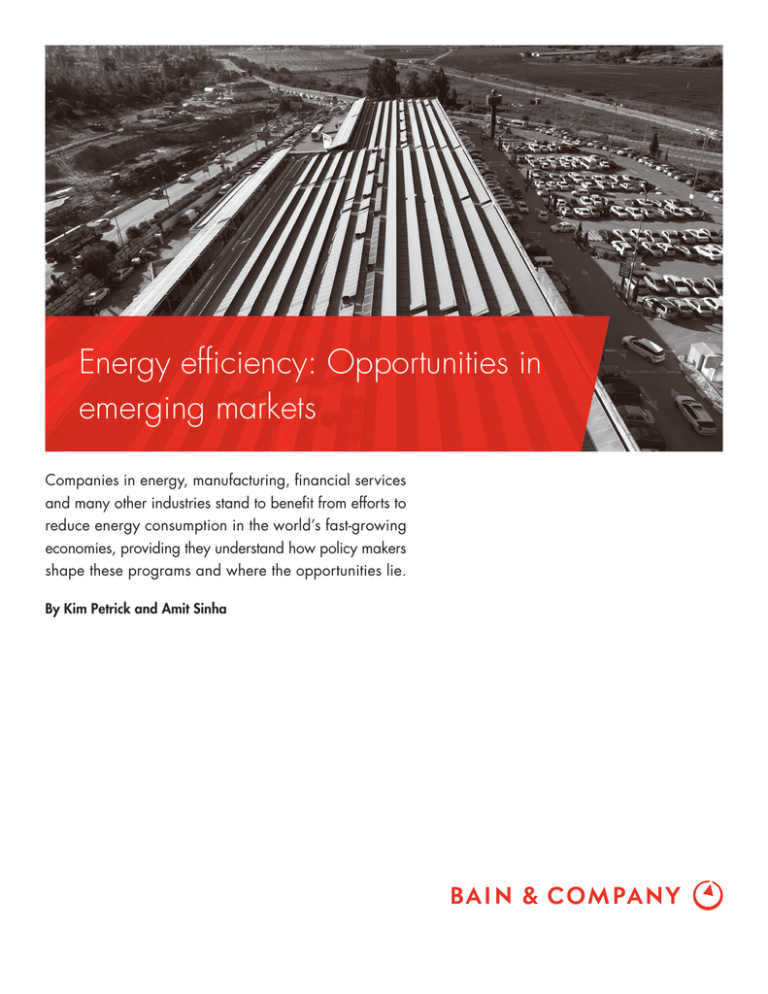
Energy efficiency: Opportunities in
emerging markets
Companies in energy, manufacturing, financial services
and many other industries stand to benefit from efforts to
reduce energy consumption in the world’s fast-growing
economies, providing they understand how policy makers
shape these programs and where the opportunities lie.
By Kim Petrick and Amit Sinha
Kim Petrick is a partner with Bain & Company in Dubai. Amit Sinha is a Bain
partner in New Delhi. Both work with Bain’s Global Utilities & Alternative
Energy practice.
For their contributions to this work, the authors would like to thank their colleagues in the Dubai office: Eric Beranger-Fenouillet, a partner; Joseph Rahi, a
principal; and Eric Guraieb, a manager.
Copyright © 2015 Bain & Company, Inc. All rights reserved.
Energy efficiency: Opportunities in emerging markets
more renewable sources. Efficiency is a more costefficient way to meet demand.
Governments in emerging markets are getting serious
about energy efficiency. Even though oil prices have
dropped dramatically since mid-2014, policy makers in
many fast-growing economies continue to recognize the
imperative to reduce domestic energy consumption and
the opportunities this presents. Even Gulf states rich in
oil and gas—such as Qatar, Saudi Arabia and the United
Arab Emirates—have established ambitious energyefficiency programs and concrete measures to reduce
energy consumption.
Raising energy efficiency requires coordination across
industrial and commercial sectors throughout a country.
Thus policy makers in fast-growing economies will
need to collaborate closely with the private sector to
achieve this. By introducing new energy regulations
and encouraging greater efficiency through incentives,
policy makers create new opportunities for a host of
businesses, such as energy service companies (ESCOs);
utilities; financial institutions; training organizations;
certification bodies; automakers; and manufacturers of
building materials, insulation, heating and air conditioning equipment, and other white goods. Some companies get involved early, bringing their expertise to help
shape the market. Others wait until standards and directions are set and then identify the opportunities where
they can best support energy transformations in these
markets. All of this takes time, and among the key traits
that winning players will bring to bear are patience and
an active local presence.
The reasons differ from one country to the next. For some,
reducing greenhouse gas emissions is important, and
for others, achieving long-term resource sustainability
is key. In most cases, the greater motivation derives
from a cost-benefit analysis: Leaders recognize the financial and economic benefits of curbing internal demand.
Among the factors they consider:
•
Domestic subsidies. Some governments would like to
reduce subsidies on transportation fuel and electricity,
which make energy more affordable for consumers
and businesses. As the price of oil has dropped, the
International Monetary Fund has encouraged countries
to reduce or remove fuel subsidies. India, Indonesia,
Mexico and Egypt, among others, are reforming
energy subsidies, and the UAE plans to phase out
transportation fuel subsidies altogether.
•
Opportunity cost of exporting at market prices. For
net exporters, every barrel consumed domestically—
whether as fuel for transport, industry or electricity
generation—is a barrel they cannot export at the
market price.
•
Economic surplus. Savings generated through energy
efficiency can be used for other economic activities
in the private and public sectors. Economic surplus
also ties directly to energy security, which is a key
imperative, especially for net importers.
•
Executives contemplating how to approach these opportunities should first understand how regulators in emerging markets develop energy-efficiency policies. This
insight lays the groundwork for considering how best
to develop successful products and services, within the
opportunities and constraints of the regulatory landscape.
Looking at how some global and regional companies
have successfully embraced energy-efficiency opportunities serves as a useful guide to spark discussion about
energy-efficiency ventures in emerging markets.
Policies that create the energy-efficiency
opportunity
In many emerging markets, government-owned organizations make up a large share of the economy. Policy
makers can lead by example, taking a comprehensive
approach to the design and implementation of energyefficiency initiatives, typically across an entire sector
such as transportation or buildings. To encourage efficiency and manage demand, governments create new
Efficiency is the cheapest source of energy. To meet
their energy needs, emerging markets traditionally
had to choose between consuming more fossil fuels
or diversifying their energy supply mix to include
1
Energy efficiency: Opportunities in emerging markets
rules, offer access to affordable financing and train new
talent—all of which fuel new business opportunities.
products (vehicles, air conditioners) with new products
that use less energy. Financing can take many forms.
Governments can tie loans to performance-based contracts that allow companies to reduce their payments
based on their success in energy efficiency. With some
contracts, an energy services company guarantees the
energy savings while the customer remains liable for
the loan. With others, the energy services company assumes the financing and technical risk, sharing any
savings with the customer. Performance-based contracts
rely on detailed measurement to verify that the claimed
energy savings are real and the result of the efficiency
measures that were implemented, rather than other
factors such as changes in the weather.
Regulations. Governments shape energy-efficiency markets as they determine the rules by which industry operates in their countries. In India, the Bureau of Energy
Efficiency created Perform, Achieve and Trade (PAT),
an incentive scheme to encourage energy savings in
nearly 500 plants across eight industries. The PAT
scheme is similar in some respects to the emissions
trading schemes seen in Europe and North America:
Companies that save more energy than their targets
receive energy savings certificates (ESCs) that they can
sell to companies that miss their goals.
The selection of technical standards also plays an important role. Governments and industries work closely with
international standards bodies, typically adopting proven
standards; they rarely reinvent the wheel but modify
where it makes sense, to meet local needs. Often they
can move faster in emerging markets than in larger
and more mature markets, because they look to international practices and experiences of early movers. The
UAE, for example, quickly followed the lead of some
developed markets in banning the sale of incandescent
light bulbs as of January 2015. Saudi Arabia has raised
efficiency requirements for new, small air conditioning
units and also announced fuel efficiency requirements
for cars and light trucks, following the lead of the US’s
Corporate Average Fuel Economy (CAFE) standards.
Despite their complexity, these financing arrangements
have increased the demand for energy services in several
fast-growing markets, by preserving the investment and
debt capacity of a customer, such as a building owner,
while generating attractive returns of typically between
20% and 40% energy savings, with a payback over four
to seven years.
Human capital development. Engineering and other
technical talent is typically more available in developed
markets. Most emerging markets’ educational systems
do not supply enough people to staff a rapidly growing,
technically based ecosystem of energy efficiency. The
efficiency initiatives create many new opportunities for
universities and organizations providing vocational
training and professional certifications, as well as financing required for each of these. Companies based in
mature markets may be able to bring their vocational
training programs as part of their investment in emerging markets, or in some cases, they may support the
training efforts of local chapters of organizations like
the Association of Energy Engineers.
Governments also set rules for procurement by public
organizations and the energy services industry. As in
mature markets, shaping the rules for government
purchasing can be a long and complex process, requiring
patience by those who would sell products and services
to government agencies. Where necessary, vendors may
need to gain accreditation with relevant government
bodies, and the companies that invest in accrediting
staff are able to move quickly into new opportunities.
Governments can fund energy-efficiency centers, provide scholarships for foreign studies in energy efficiency
and push the development of energy-efficiency courses
and programs in state universities. Energy-efficiency
centers educate students and professionals in energy
efficiency, conduct research, facilitate technology transfer,
disseminate knowledge, provide training, and strengthen
graduate studies and applied research.
Financing. Governments fund energy-efficiency measures using direct investments in the energy services
industry, public-private partnerships and incentives like
tax reductions. In some cases, they create incentive programs to encourage early replacement of older, inefficient
2
Energy efficiency: Opportunities in emerging markets
Creating successful energy products and services
services. Those that want to influence the market may
come in early and aim for a broader role in the landscape—
as a platform developer or a provider of breakthrough
technologies or business models that create opportunities for others. Depending on their role, energy companies will find different opportunities for success along
the energy-efficiency value chain (see Figure 1).
Businesses can take a three-step approach to creating
energy-efficiency products and services.
Understand the rules. Companies must gain a solid
understanding of the ways that regulators structure
policies, regulations and incentives for energy-efficiency
programs. Designing programs to encourage the formation of an energy services industry differs from making
rules that would prohibit certain energy uses—though
both aim at increasing energy efficiency. Even where
standards align with international norms that multinational corporations may be familiar with, processes
for compliance may differ.
Develop the value proposition. Companies must develop
a competitive value proposition and business model,
as well as the capabilities that will help them deliver
on their goals. For businesses entering emerging markets, a key aspect of this process is determining whether
their products or services are suitable, or require substantial reinvention. They should also assess what skills
are needed and what partnerships might be beneficial.
Finally, they must evaluate their geographic capabilities:
In one region, they may have the necessary people and
assets for success, but find they are unable to replicate
it in another.
Define your role. With a clear view of the regulatory
landscape, businesses can begin to identify their position in the industry, relevant market opportunities and
prospective customers. Most will enter the market with
the goal of delivering a limited set of products and or
Figure 1: Companies in the energy-efficiency ecosystem are positioned for success at different points along
the value chain
Energy
supplier
Diagnostics
& consulting
Technical
design
Product &
equipment
manufacturing
Installation
Operations
&
maintenance
Energy
supply
Data
management
& steering
Financing
Energy
services
company
Diagnostics
& consulting
Technical
design
Product &
equipment
manufacturing
Installation
Operations
&
maintenance
Energy
supply
Data
management
& steering
Financing
Manufacturers
Diagnostics
& consulting
Technical
design
Product &
equipment
manufacturing
Installation
Operations
&
maintenance
Energy
supply
Data
management
& steering
Financing
Low
Ability to win
Medium
Source: Bain analysis
3
High
Energy efficiency: Opportunities in emerging markets
Key capabilities for success in emerging markets reduced battery costs to boost adoption of electric vehicles, and other global automakers are watching closely
to see how they may have to adapt their plans. China’s
regulators could pivot quickly to electric vehicle-friendly
rules if they see a national player ahead of the curve.
Several examples of winning ventures in energy efficiency
illustrate four critical capabilities required for success
in emerging markets: product innovation, embracing
local preferences, partnering with other organizations
and geographic repeatability.
Partnering in district utility infrastructure. In Qatar,
where air conditioning represents a large share of energy
use, Qatari holding company United Development
Company partnered with Tabreed, a UAE-based cooling
solutions company, to establish Qatar Cool in 2003.
Qatar Cool provides district cooling services, chilling
water at a central location then distributing it to nearby
buildings, where it helps to produce air conditioning—
an efficient alternative to conventional cooling. While
Tabreed brought to the partnership its experience in
designing energy-efficient cooling plants, the new
company’s success also depended on United Development Company’s involvement in Qatar’s real estate
developments. Qatar Cool supplies district cooling to
the residents of West Bay and Pearl-Qatar in Doha.
Product innovation in financial services. India’s Bureau
of Energy Efficiency develops policies and initiatives to
help reduce the country’s energy intensity, including
innovative financing of energy-efficiency projects. ICICI,
a private bank in India, was one of several to embrace
this program. It introduced a loan scheme to help commercial and industrial companies, small and midsize
enterprises and public sector organizations finance energyefficiency services and purchase equipment and lighting
for energy-efficiency projects. A $350 million loan from
the World Bank supports these efforts, with most loans
delivered over three to five years at 7% to 9% annual rates.
The energy savings from these projects range from 15%
to 30%.
Geographic repeatability in energy services. Johnson
Controls, a US-based company that manages heating,
cooling and energy systems in commercial buildings,
is expanding into emerging markets. Its energy service
company in Singapore retrofitted Corporation Place, a
large commercial building that leases space to manufacturing, electronics and IT companies, resulting in a 58%
improvement in energy efficiency and about $540,000
in energy savings annually.
For example, ICICI financed new street lighting in the
city of Nashik in Maharashtra. During the first phase of
this project, officials replaced half of the city’s 25,000
streetlights with energy-efficient lights, resulting in
energy savings of 30% during the first year.
Embracing local requirements in automotive. Most
developing markets are too small to set proprietary fuelefficiency standards for automakers, so many adopt
European or US standards. US, Japanese and European
standards may converge in 2025, although local markets
may continue to tailor them to their needs; for example,
policy makers in a warmer region may take into account
greater energy demands from car air-conditioning systems. Advancements in internal combustion-engine
technology—such as turbo engines, gasoline direct injection and start-stop transmissions—will drive energy
efficiency in traditional automobiles.
Across emerging markets, the push to become more
energy efficient will continue to create opportunities
for many players in the energy sector and beyond, including energy providers, energy service companies,
product manufacturers, finance companies, automakers,
data analysts, training companies and education providers. Success requires a clear understanding of the goals
and methods of policy makers’ efficiency programs and
your organization’s competitive advantages and challenges, as well as a focused effort to build and refine the
necessary capabilities to capture these opportunities.
In some markets, regulators look for breakthroughs in
electric vehicle technology and other new-energy vehicle
technologies. Chinese automaker BYD is betting on
4
Shared Ambit ion, True Results
Bain & Company is the management consulting firm that the world’s business leaders come
to when they want results.
Bain advises clients on strategy, operations, technology, organization, private equity and mergers and acquisitions.
We develop practical, customized insights that clients act on and transfer skills that make change stick. Founded
in 1973, Bain has 51 offices in 33 countries, and our deep expertise and client roster cross every industry and
economic sector. Our clients have outperformed the stock market 4 to 1.
What sets us apart
We believe a consulting firm should be more than an adviser. So we put ourselves in our clients’ shoes, selling
outcomes, not projects. We align our incentives with our clients’ by linking our fees to their results and collaborate
to unlock the full potential of their business. Our Results Delivery® process builds our clients’ capabilities, and
our True North values mean we do the right thing for our clients, people and communities—always.
Key contacts in Bain’s Global Utilities practice:
Americas:
Matt Abbott in Los Angeles (matt.abbott@bain.com)
Neil Cherry in San Francisco (neil.cherry@bain.com)
Paul Cichocki in Boston (paul.cichocki@bain.com)
Antonio Farinha in São Paulo (antonio.farinha@bain.com)
Jason Glickman in San Francisco (jason.glickman@bain.com)
Mark Gottfredson in Dallas (mark.gottfredson@bain.com)
Alfredo Pinto in São Paulo (alfredo.pinto@bain.com)
Tina Radabaugh in Los Angeles (tina.radabaugh@bain.com)
Joseph Scalise in San Francisco (joseph.scalise@bain.com)
Bruce Stephenson in Chicago (bruce.stephenson@bain.com)
Jim Wininger in Atlanta (jim.wininger@bain.com)
Asia-Pacific:
Sharad Apte in Bangkok (sharad.apte@bain.com)
Wade Cruse in Singapore (wade.cruse@bain.com)
Miguel Simoes de Melo in Sydney (miguel.simoes-demelo@bain.com)
Amit Sinha in New Delhi (amit.sinha@bain.com)
Europe,
Middle East
and Africa:
Alessandro Cadei in Milan (alessandro.cadei@bain.com)
Julian Critchlow in London (julian.critchlow@bain.com)
Arnaud Leroi in Paris (arnaud.leroi@bain.com)
Kim Petrick in Dubai (kim.petrick@bain.com)
Timo Pohjakallio in Helsinki (timo.pohjakallio@bain.com)
Tim Polack in London (tim.polack@bain.com)
Jacek Poswiata in Warsaw (jacek.poswiata@bain.com)
Roberto Prioreschi in Rome (roberto.prioreschi@bain.com)
For more information, visit www.bain.com










